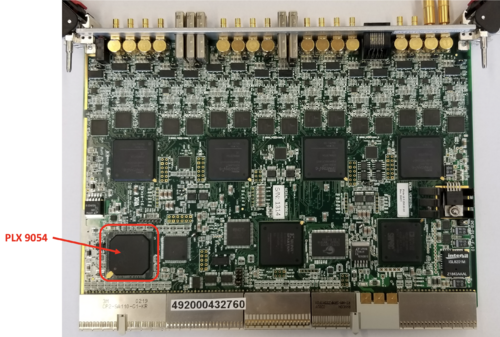Pixie16 digitizer
Introduction
In order to control the Pixie16 digitizer, the DAQ computer needs to recognize the digitizer via a PCIe card( for example NI PCI-8366).
The digitizer crate (XIA PXI CompactPCI) has 14-slot. The 1st slot must be the communication card (for example, NI PXI-8366). The remaining 13 slots can be used for digitizer and other modules.
The PCIe card and PXI Board requires no driver. The DAQ computer will treat it as a bridge.
In the computer (LINUX), using the command lspci to show the PCI connection
>lspci
as an example, part of the output:
04:00.0 PCI bridge: Intel Corporation 41210 [Lanai] Serial to Parallel PCI Bridge (A-Segment Bridge) (rev 09) 04:00.2 PCI bridge: Intel Corporation 41210 [Lanai] Serial to Parallel PCI Bridge (B-Segment Bridge) (rev 09) 05:0f.0 Unassigned class [ff00]: National Instruments PXI-8368 06:05.0 PCI bridge: Texas Instruments PCI2050 PCI-to-PCI Bridge (rev 02) 06:0f.0 Bridge: PLX Technology, Inc. PCI9054 32-bit 33MHz PCI <-> IOBus Bridge (rev 0b)
In the above output, the NI PXI-8368 board on the crate is detected. Also the PCI9054 communication chip is detected.
The PCI9054 (or PLX9054) chip is located at the corner of the Pixie16 digitizer.
The PCI9054 chip requires a driver. The driver is provided by Broadcom, and the package is called PlxSDK. (The Broadcom PCI/PCIe Software Development Kits [1]).
After the driver for the PCI9054 chip is done, the DAQ PC can talk to the digitizer. Next, the PixieSDK has to be installed for controlling the digitizer. The PixieSDK provides methods to control the digitizer.
Broadcom PlxSDK
The chip was a product of PLX Technology, acquired by Broadcom Inc in 2014. The chipset driver is now called the Broadcom PCI/PCIe Software Development Kits [2]. The package provides complete documentation and driver. The last release is on 2020.
installation
After downloaded the package, unzip it, and we have
├── Documentation │ ├── PLX API DLL with Visual Basic.htm │ ├── PLX_LegacyAPI.pdf │ ├── PlxRdkReferenceGuide.htm │ ├── PLX_SDK_General_FAQ.pdf │ ├── PLX_SDK_Linux_Release_Notes.htm │ ├── PLX_SDK_Release_Notes.htm │ └── PlxSdkUserManual.pdf └── PlxSdk.tar
The tarball contains the driver. I extract the tarball into /usr/opt/PlxSdk
├── Bin
│ ├── Plx_load
│ ├── Plx_unload
│ └── startlog
├── COPYING
├── Driver
│ ├── buildalldrivers
│ ├── builddriver
│ ├── Makefile
│ ├── Source.Plx6000_NT
│ │ ├── ...
│ ├── Source.Plx8000_DMA
│ │ ├── ...
│ ├── Source.Plx8000_NT
│ │ ├── ...
│ ├── Source.Plx9000
│ │ ├── ApiFunc.c
│ │ ├── ApiFunc.h
│ │ ├── Chip
│ │ │ ├── ...
│ │ │ ├── 9054
│ │ │ │ ├── PlxChipApi.c
│ │ │ │ ├── PlxChipFn.c
│ │ │ │ └── PlxInterrupt.c
│ │ │ ├── ...
│ │ ├── ....
│ └── Source.PlxSvc
│ ├── ....
├── Include
│ ├── ....
├── Makefile
├── Makefiles
│ ├── ...
├── PlxApi
│ ├── ...
└── Samples
├── ApiTest
│ ├── ApiTest.c
│ └── Makefile
├── DSlave
│ ├── DSlave.c
│ └── Makefile
├── DSlave_BypassApi
│ ├── ...
├── ...
Pixie SDK
Legacy PixieSDK
PixieSDK 3.2
Pixie SDK for control.
PixieSDK 3.3
DAQ Programs
NSCL DAQ
PixieDAQ
PixieDAQ is a GUI program for complete controlling and taking data from Pixie16 digitizer, developed by Ryan Tang. The program used the PixieSDK 3.3 and ROOT 6.24.
NSCOPE
nscope is a GUI program for setting digitizer parameters, developed by David Caussyn. The program used the Legacy PixieSDK, CERN ROOT 5.

